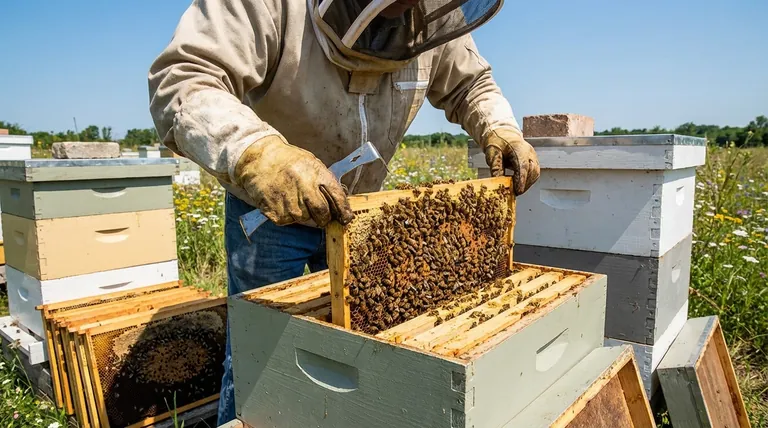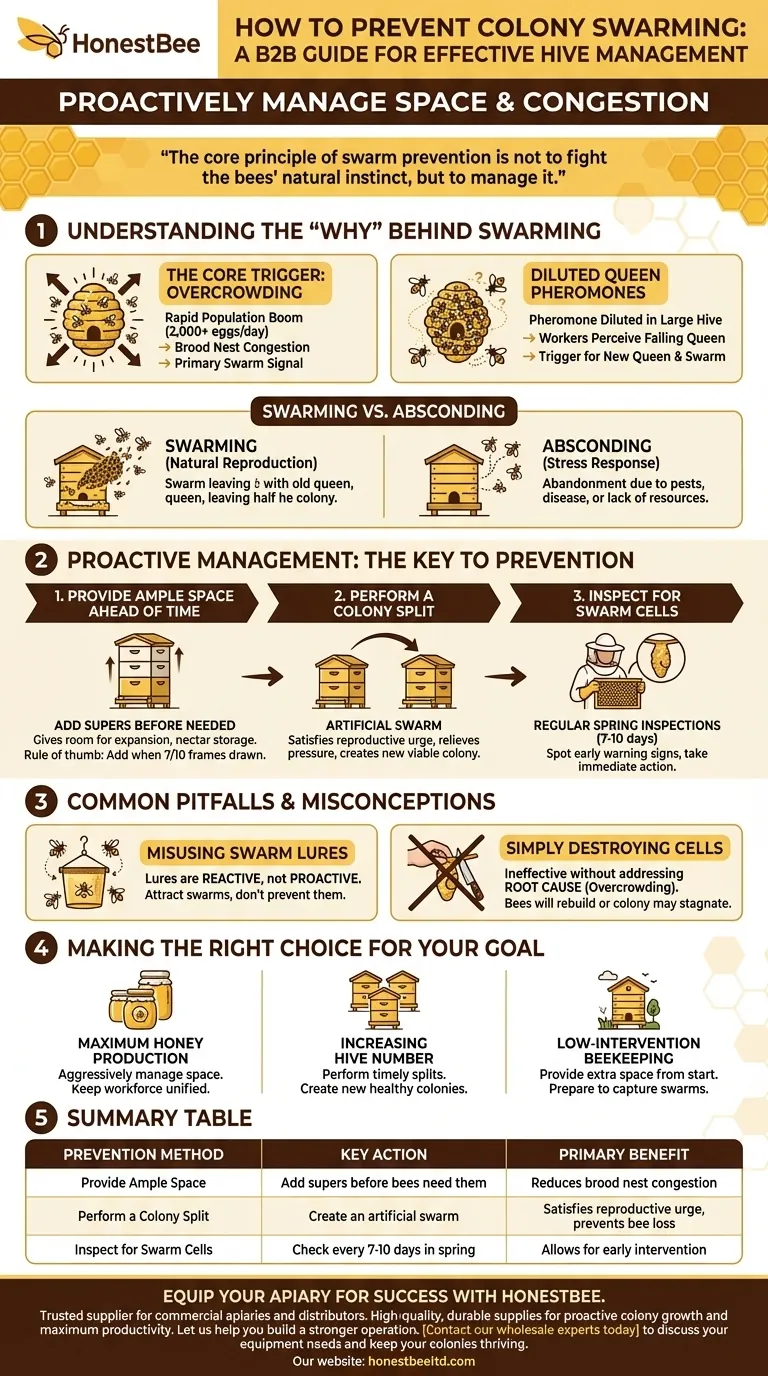To prevent a honey bee colony from swarming, you must proactively manage the hive's space to alleviate the two primary triggers: population growth and brood nest congestion. Swarming is a natural reproductive process that a colony decides upon weeks in advance, so preventative actions focus on creating conditions where the bees no longer feel the impulse to divide.
The core principle of swarm prevention is not to fight the bees' natural instinct, but to manage it. By providing adequate space and occasionally intervening to mimic the outcome of a swarm, you can keep the colony intact, productive, and in your hive.

Understanding the "Why" Behind Swarming
Before you can manage the swarm impulse, you must understand what drives it. Swarming is a sign of a healthy, thriving colony that has successfully outgrown its current home.
The Core Trigger: Overcrowding
A strong queen can lay over 2,000 eggs per day. This leads to a rapid population boom in the spring.
When the hive becomes packed with bees, the queen runs out of empty cells in the brood nest to lay eggs. This congestion is the primary signal that it's time to swarm.
Diluted Queen Pheromones
The queen produces a pheromone that signals her presence and viability to the entire colony.
In a very large, crowded hive, this pheromone gets diluted and doesn't reach all the workers effectively. This leads the bees to believe the queen is failing, prompting them to create a new queen in preparation for swarming.
Swarming vs. Absconding
It is critical to distinguish between swarming and absconding.
Swarming is natural reproduction where the old queen leaves with about half the bees to create a new colony, leaving the original hive to raise a new queen.
Absconding is when the entire colony abandons the hive. This is a stress response, often caused by pest pressure (like varroa mites), disease, or a lack of resources.
Proactive Management: The Key to Prevention
Effective swarm management begins long before you see the first signs. The goal is to stay ahead of the colony's growth curve.
Provide Ample Space Ahead of Time
The simplest and most important preventative measure is to add more boxes (supers) before the bees need them.
Adding a new super gives the colony room to expand, store nectar, and reduces congestion in the brood nest. A good rule of thumb is to add a super when the bees have drawn out comb on 7 of the 10 frames in the top-most box.
Perform a Colony Split
The most definitive way to prevent a swarm is to perform an "artificial swarm," known as a split.
By splitting the colony yourself, you are satisfying the bees' natural reproductive urge on your own terms. You create two viable colonies, relieve the pressure within the original hive, and prevent the loss of your bees.
Inspect for Swarm Cells
Regular inspections (every 7-10 days in spring) are crucial for spotting the early warning signs.
Bees will build queen cells, which look like peanut shells hanging from the frame, in preparation to swarm. If you see these cells with larvae and royal jelly inside, a swarm is imminent, and you must take immediate action like splitting the hive.
Common Pitfalls and Misconceptions
There is a great deal of misunderstanding about certain tools and techniques. A clear understanding of what works—and why—is essential.
The True Purpose of a Swarm Lure
A swarm lure does not prevent swarming. Its purpose is to attract a swarm that has already left a hive.
These lures use pheromones to make a box (a "swarm trap") seem like an ideal new home. They are a reactive tool for catching swarms, not a proactive tool for preventing them.
The Mistake of Simply Destroying Cells
If you find swarm cells, simply cutting them out without addressing the root cause (overcrowding) is rarely effective.
The bees' swarming impulse is already in full swing. They will likely just build new swarm cells, and if they don't succeed, the colony may become stagnant or unproductive. The only solution is to relieve the congestion through splitting or adding significant space.
Making the Right Choice for Your Goal
Your approach to swarm management should align with your beekeeping objectives.
- If your primary focus is maximum honey production: Manage space aggressively by adding supers well ahead of time to keep the workforce unified and focused on foraging.
- If your primary focus is increasing your number of hives: Perform timely splits as soon as you see signs of swarm preparation to create new, healthy colonies under your control.
- If your primary focus is low-intervention beekeeping: Give your colonies more space than you think they'll need from the start and be prepared to capture the swarms that will inevitably issue.
Ultimately, successful swarm management is about working with the powerful, natural instincts of your bees, not against them.
Summary Table:
| Prevention Method | Key Action | Primary Benefit |
|---|---|---|
| Provide Ample Space | Add supers before bees need them | Reduces brood nest congestion |
| Perform a Colony Split | Create an artificial swarm | Satisfies reproductive urge, prevents bee loss |
| Inspect for Swarm Cells | Check every 7-10 days in spring | Allows for early intervention |
Equip your apiary for success with HONESTBEE.
Managing swarming effectively requires the right equipment to provide ample space and perform timely splits. As a trusted supplier for commercial apiaries and beekeeping equipment distributors, HONESTBEE provides the high-quality, durable beekeeping supplies you need to manage colony growth proactively and maximize productivity.
Let us help you build a stronger operation. Contact our wholesale experts today to discuss your equipment needs and keep your colonies thriving.
Visual Guide

Related Products
- HONESTBEE Advanced Ergonomic Stainless Steel Hive Tool for Beekeeping
- Professional Dual-End Stainless Steel Hive Tool for Beekeeping
- Full Set Beekeeping Electronic Bee Venom Collector Machine Device for Bee Venom Collecting
- Wooden Bee Brush with Triple Row Artificial Fiber for Beekeeping
- No Grafting Queen Rearing Kit: System for Royal Jelly Production and Queen Rearing
People Also Ask
- What is the hole in a hive tool for? A Multi-Tool for Apiary Repairs and Maintenance
- What are some common uses of a hive tool? Essential Multi-Purpose Tool for Every Beekeeper
- How is a hive tool used for scraping and cleaning? Master Hive Maintenance for a Healthy Colony
- What are the basic tools for beekeeping? Essential Starter Kit for Safe & Successful Hive Management
- What tools are used for cleaning frames? A Beekeeper's Simple 4-Tool Guide



















